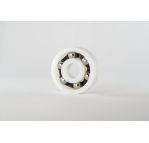
Flanged plastic ball bearings for shaft sizes from 0.125” to 0.50” diameter
See product table below for dimensions and technical drawings
See Products Variants below for non-flanged options
Our inch sized flanged plastic ball bearings have solid plastic flange on the outer ring. This allows the bearing to be more easily located in a housing. The flange can also help to prevent axial movement of the bearing in the event of a thrust load on the bearing. It is also easier to maintain the position of a flanged bearing in the housing where a lot of vibration is present.
Flanged plastic bearings are made with acetal (POM-C) rings and nylon (PA66) cages and offer a low-cost, corrosion resistant option. These bearings are also non-conductive. Bearings with glass balls or plastic balls are non-magnetic while those with 316 stainless steel balls are very slightly magnetic. Acetal resin has excellent corrosion resistance. As it is a much softer material than chrome steel or 440 grade stainless steel, plastic bearings are only suitable for low load and low speed use. Flanged plastic bearings cannot be manufactured to tight tolerances so they are only suitable for low precision applications. See Products Variants below for non-flanged plastic bearings.
The inch sized plastic bearings, shown in the table below, are highly resistant to saltwater and many aggressive chemicals. We can supply plastic bearings with alternative ring or cage materials, such as PEEK, PTFE or PVDF, for greater corrosion resistance or extreme temperatures. Please note that plastic is more prone to temperature induced expansion and contraction. The standard bearings are open but may be supplied with plastic shields on request. See Bearing Materials for more information on plastic grades.
Acetal bearings with nylon cages have a temperature range of -30°C to 100°C. This range can be extended with the use of different ring and cage materials. PTFE can be used down to -190°C while PEEK is a good high temperature option for up to 250°C.
Click on INFO in the rows below to display technical drawings of the bearings with load and speed data. Please note that the maximum loads and speeds are used in theoretical life calculations. It is recommended to use bearings at significantly less than the maximum load and speed ratings to ensure reasonable bearing life.

